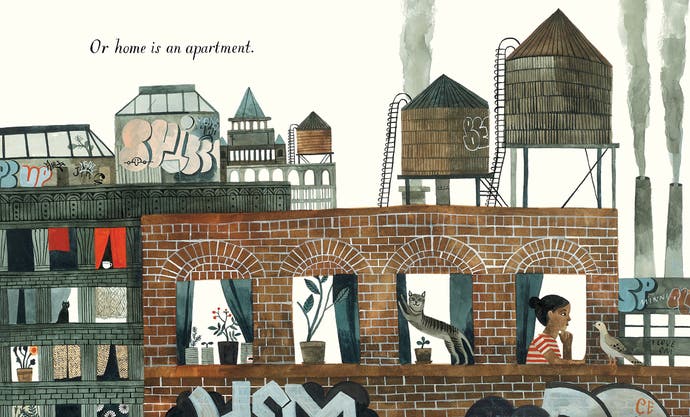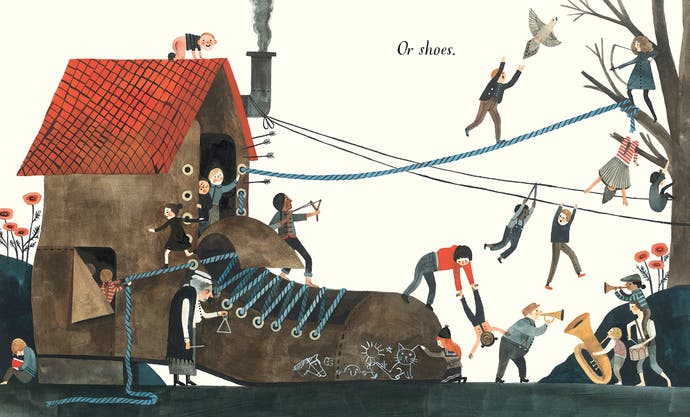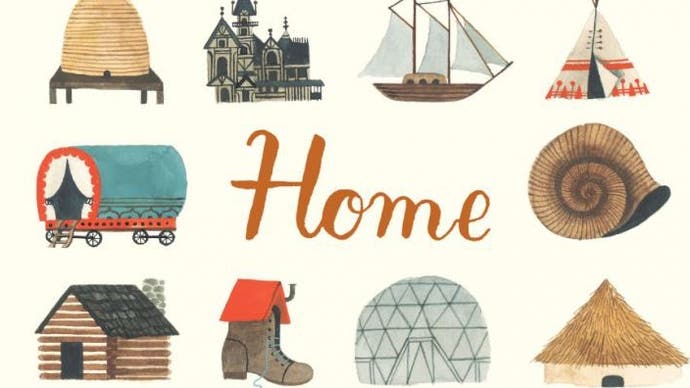Home is a book, a puzzle, and a clue as to why some games are so fascinating
"Who in the world lives here?"
Home is a children's book by the writer and illustrator Carson Ellis. It's concerned, as you might expect, with all the sorts of places that people might find to live.
The book is built around a series of paintings by Ellis - watercolours, I think, but I might be wrong about this stuff. And it's quietly fantastical, if such a combination is possible. "Home is a house in the country," is how the whole thing kicks off, and there's a nice little house with a red brick chimney, and a couple of horses running nearby. "Or home is an apartment," it continues: brickwork, graffiti, a cat stretching itself in a window while a girl in another window seems to be studying a nearby pigeon. Pages later, however, we learn that some people live in palaces, or underground lairs. Some people live in shoes or on the moon. Each illustration is delicate, detailed, and wonderfully, organically strange. This is a peculiarly unforced kind of strangeness: of course a Japanese businessman lives in a sort of geometrical papercraft rock with a chimney poking out of the top. Of course he shares the double-page spread with a Norse god and his wooden church. This is that kind of imagination that has a sense of certainty to it - its fancies do not feel like fancies at all. They feel like clear-eyed reports from another world that has its own rules and its own rigour.
But Home is also a game. At least I think it is. I think it has the space inside it to be a game.
And it's all because of a teacup. A little white teacup with a curved base and a single blue ring serving as decoration.

The teacup pops up for the first time on the second spread of Home, "Or home is an apartment." It's resting on a window ledge in a room with partially parted red curtains. Looking back to the first page, I now see that the ring on the teacup is the same kind of blue as the doors and shutters of the house in the country, and the same colours as a neat row of bluebells bowing their heads in the yard.
But go forwards: there's the teacup again, a few pages later, held by a gadabout holding forth on a Greyhound bus. It's on the porch of the messy home the next page after that. It's huge and upended a few pages later as part of a sort of leaf- and dew-drop-scale home that always makes my daughter think of Tinkerbell's house, and then it's pretty much everywhere - sat alone in the sink in the babushka's house, stood next to a chaise longue in the Moonian's house, where Earth hovers outside the window. On and on I keep spotting that cup.
At the end of the book the teacup turns up one last time. "An artist lives here," and here's a red-haired illustrator in a wooly hat, sat with her back to us as she finishes a painting at a large desk in an attic studio filled with lovely clutter. The teacup weights down one corner of the painting, and the painting is the house in the country, with the horses and the bluebells and the red brick chimney. Next to the painting, Las Meninas-style, is a plate that serves as a sort of artist's palette, splodged with many of the colours that have been used to put the book together. There's the very blue, in fact, that gives the teacup its signature design.

Turn the final page and we're back in the house in the country and it's clear now, from the face in the attic window, that this is Carson Ellis' house and studio. "This is my home and this is me," she writes. "Where is your home? Where are you?"
It's impossible to read these last few pages without going back to the beginning of the book immediately afterwards. Because here's the game: the teacup isn't the only object that I recognise in the artist's studio. There's so much more to discover, to spot. There's a red banner with the letters VH that flies from the top of the Norse god's house. There's a fish-tank which has an underwater castle I recognise. There's the earth that hung outside the Moonian's window, except now it's a desk globe. There's the horse, a leaf, a yard of cloth, the boot, a ship in a bottle, a shape that might be a dreamcatcher.
You reach the end of Home, a book in which you get to travel so far, and to such strange places, and you realise that the artist has never actually left their studio, that they've been inspired to a certain degree by the items they keep to hand as they work. And that's your cue as a reader to set to work re-reading the book, really studying the illustrations, spotting the uses and reuses of various props while the whole thing gets richer, while the connections become more playful.

When asked about the fate of humankind in the universe, Einstein once said - and I am paraphrasing here, from my memory of reading about all this in Driving Mr Albert, by Michael Paterniti - that he imagined humankind as a child walking through a vast library. The child can't read and they can't understand how the books are made or what's inside them. They can't even understand the order in which they're arranged on the shelves. But they can understand, innately, that there is an order to this library.
I think about this with games a lot, about the bottled universes where heroes and villains race around, never sensing that there is a game engine that controls their every action and reaction, that keeps them fixed within parameters, and forever separates what is possible and what is impossible. Sometimes, for the player, testing the edges of these worlds becomes half the fun of a game - more than half the fun, even. (If you've ever watched a developer play someone else's game, you might think it was the only fun.)
And I think about the Einstein thing in relation to Home, too, in which the whole world and everything in it is ultimately a reflection of the artist's inspirations and their choices as they sit in an attic studio. And the game, as it were, lies in understanding how this world they've made has come to be.

